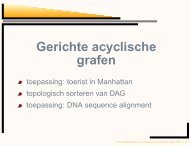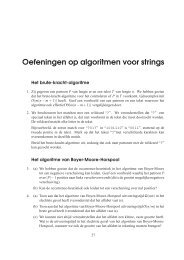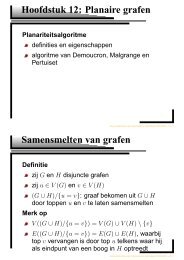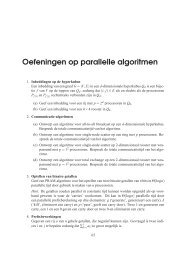Here - Combinatorial algorithms and algorithmic graph theory
Here - Combinatorial algorithms and algorithmic graph theory
Here - Combinatorial algorithms and algorithmic graph theory
You also want an ePaper? Increase the reach of your titles
YUMPU automatically turns print PDFs into web optimized ePapers that Google loves.
4 Introduction<br />
path is its number of edges.<br />
The distance d(v, w) between 2 vertices v, w ∈ V (G) is the length of the<br />
shortest path from v to w in G. If there is no path from v to w, d(v, w) is defined<br />
as ∞. The diameter of G is the greatest distance between any two vertices in G.<br />
A sub<strong>graph</strong> C of a <strong>graph</strong> G is a cycle if V (C) = {v 0 , v 1 , ..., v n } <strong>and</strong> E(C) =<br />
{{v i , v i+1 } | 0 ≤ i < n} ∪ {v 0 , v n } where all vertices of V (C) are distinct. The<br />
length of the cycle is its number of edges (or vertices).<br />
A complete <strong>graph</strong> of order n (denoted K n ) is a <strong>graph</strong> G = (V, E) with E = ( V<br />
2)<br />
.<br />
A <strong>graph</strong> G is called bipartite if there are two sets of vertices V 1 <strong>and</strong> V 2 such<br />
that V 1 ∩ V 2 = ∅ <strong>and</strong> V 1 ∪ V 2 = V (G) <strong>and</strong> ∀ e ∈ E(G) : |e ∩ V 1 | = |e ∩ V 2 | = 1.<br />
A complete bipartite <strong>graph</strong> G = (V 1 ∪V 2 , E) is a bipartite <strong>graph</strong> with partitions<br />
V 1 <strong>and</strong> V 2 such that for any two vertices v 1 ∈ V 1 <strong>and</strong> v 2 ∈ V 2 , {v 1 , v 2 } is an edge<br />
in G. The complete bipartite <strong>graph</strong> with partitions of size |V 1 | = m <strong>and</strong> |V 2 | = n,<br />
is denoted K m,n .<br />
The girth of a <strong>graph</strong> G is the length of its shortest cycle <strong>and</strong> is denoted by<br />
g(G). For acyclic <strong>graph</strong>s the girth is defined as ∞. A tree is a connected acyclic<br />
<strong>graph</strong>.<br />
A <strong>graph</strong> G = (V, E) is connected if for every v, w ∈ V there is a path from v<br />
to w. A disconnected <strong>graph</strong> is a <strong>graph</strong> which is not connected. Given a connected<br />
<strong>graph</strong> G = (V, E). A set S ⊆ V is a vertex-cut if G[V \ S] is disconnected. If the<br />
vertex-cut only contains one vertex, we call that vertex a cutvertex. A <strong>graph</strong> G<br />
is k-connected if G is connected <strong>and</strong> no vertex-cut S exists with |S| < k.<br />
Given a connected <strong>graph</strong> G = (V, E). A set S ⊆ E is an edge-cut if the<br />
<strong>graph</strong> G ′ = (V, E \ S) is disconnected. If the edge cut only contains one edge, we<br />
call that edge a bridge. A <strong>graph</strong> G is k-edge-connected if G is connected <strong>and</strong> no<br />
edge-cut S exists with |S| < k. We call an (edge) cut S with |S| = k a k-(edge)-<br />
cut. Thus if a <strong>graph</strong> is k-edge-connected but not (k + 1)-edge-connected, it has<br />
a k-edge-cut.<br />
A <strong>graph</strong> G is cyclically k-edge-connected if the deletion of fewer than k edges<br />
from G does not create two components both of which contain at least one cycle.<br />
The largest integer k such that G is cyclically k-edge-connected is called the cyclic<br />
edge-connectity of G <strong>and</strong> is denoted by λ c (G). If no set of edges can be deleted<br />
such that two components are created which both contain at least one cycle, the<br />
cyclic edge-connectivity is defined as ∞ (so λ c (K 4 ) = ∞).<br />
The chromatic index χ ′ (G) of a <strong>graph</strong> G is the minimum number of colours<br />
required for an edge colouring of that <strong>graph</strong> such that no two adjacent edges have<br />
the same colour.
















